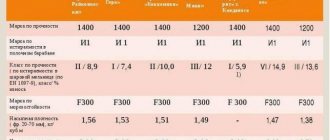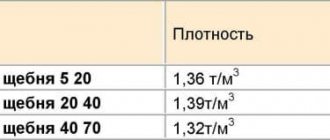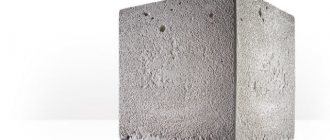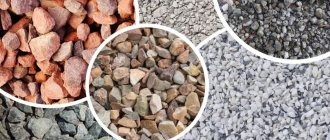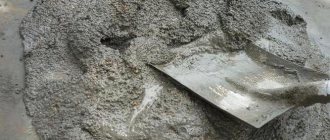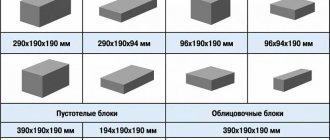Crushed stone is a very popular building material used at various stages of construction work. Crushed stone can be of primary and secondary origin. Thus, fine crushed stone obtained from inorganic raw materials is of natural origin. It is obtained during an explosion, after which the stone blocks are crushed using special equipment. But slag waste from metallurgical production, asphalt and brick fragments are crushed stone of secondary origin.
As is known, in the process of grinding natural granite or stone, particles of different sizes are obtained. Further, depending on the size of the resulting pieces of crushed stone, it is divided into fractions. Considering that voids are formed between the elements of crushed stone in a bulk natural state, the size of which depends on the size of the parts themselves, the concept of “volumetric weight” has appeared in construction, which is used when calculating the amount of material that is transported in the back of a truck.
The volumetric weight of crushed stone is the mass of a unit volume (1 m3) of raw materials without compaction, measured in t/m3; kg/m3; g/cm3. Often this concept is replaced by other expressions that essentially have the same meaning: specific gravity, bulk density or bulk specific density. The magnitude of these concepts depends on the following factors: the size of individual particles, the type of source material, humidity, and flakiness.
We will omit the first parameter for now and talk about its effect on the volumetric weight a little later. At the moment we are interested in the rock from which the material was obtained. It is this that is the determining factor, because different types of stone have different degrees of water absorption, which is why the volumetric mass of crushed stone in the raw material will be greater.
In addition, let's consider another indicator characterizing crushed stone, namely flakiness. This is a physical parameter that expresses the size of the plane of crushed stone particles, which are divided into needle-shaped and plate-shaped elements. The flakiness parameter is determined by the percentage of angular stones to the total amount of material. According to the flakiness parameters, crushed stone is divided into: cuboid (up to 10%); improved (10-15%); regular (15-25%); regular (25-35%); normal (35-50%).
Particles of the 5th, last group of flakiness, are classified as low-grade materials. It is used for filling holes, including during road works, and is also used for railway embankments.
Weight m3 of crushed stone: main aspects
Crushed stone is a material that is mined in a quarry. How long the constructed buildings will last depends on its technical characteristics. When arranging any object, you initially need to determine how much materials are needed. To do this, such an important indicator as the crushed stone fraction is taken into account.
There are different types of materials on sale. The specific choice depends on the tasks at hand. The assortment includes crushed stone of different fractions:
- screenings are a by-product that is formed during the extraction of crushed stone. It is used for filling paths and laying paving slabs;
- 5-10 mm is a fine fraction used to achieve different purposes. For example, concrete production;
- 5-20 mm is a common material that is widely used in concrete work and in the construction of airfield pavement;
- 20-40 mm – medium size fraction. Such crushed stone is used in the construction of highways, tram tracks, as well as when pouring the foundation for a house;
- 40-70 mm – large fraction. This type of non-metallic material is indispensable in the manufacture of massive structures, in the construction of structures, in the construction of the lower surface of roads;
- 70-120 mm is an irregularly shaped stone. It is used when creating gabions and finishing fences.
If you are interested in how much crushed stone is in 1 m3 , pay attention to its fraction. This is a significant parameter that cannot be neglected. For example, crushed stone with a fraction of 5 mm weighs less than stones with a fraction of 40 mm. Taking this indicator into account, it is possible to correctly determine the volume of materials required for the construction of the facility.
Weight of dropouts
home ⇒ construction mat ⇒ miscellaneous
Granite screenings are most often used when laying asphalt; one cubic meter of it weighs about 1340 (kg).
Weight of one cubic meter of screenings:
- Granite - from 1320 to 1340 (kg), gravel - about 1400 (kg), limestone - 1300 (kg).
Screenings are the smallest fraction of crushed stone, accounting for about 20% of the total mass of crushed stone when crushing rock, the grain size of screenings ranges from 0.1 (mm) to 5 (mm).
Important: screenings of various types are used for concreting, if a smooth surface is needed; it is also often used for filling paths, stadiums, road drainage, and so on.
Total mass of crushed stone screenings Drawing Drawing and parameters of a standard model Granite (kg) Mass of a cubic meter of granite screenings in (kg) Gravel (kg) Mass of a cubic meter of gravel screenings in (kg) Limestone (kg) Mass of a cubic meter of limestone screenings in (kg)
| Dropout | from 1320 (kg) to 1340 (kg) | 1400 (kg) | 1300 (kg) |
Table of screening mass Type Type of screening Fraction (mm) Particle fraction size in (mm) Cube (kg) Weight of a cubic meter of screening in (kg) Bucket (kg) Weight of a 12 liter screening bucket without packaging in (kg)
| Granite | from 0.1 (mm) to 5 (mm) | 1330 (kg) | 15.96 |
| Gravel | from 0.16 (mm) to 2.5 (mm) | 1400 | 16.8 |
| Limestone | from 2 (mm) to 5 (mm) | 1300 | 15.6 |
How many m3 are in a ton of crushed stone?
To answer this question, you need to determine the density of the materials. There are two types of this indicator. The first option is the true density of crushed stone. This indicator is determined in laboratory conditions. It means the mass per unit volume, which does not take into account existing voids. This value is determined using a special formula. The laboratory staff are well versed in the intricacies of their profession. Therefore, they easily calculate the true density of stones.
The second option is bulk density. This is a term used to describe the relationship between the mass of stones and the volume, taking into account the presence of free space between the particles. When answering the question of how much crushed stone is in 1 m3 , this parameter is extremely important. Bulk density or, as they also say, the specific gravity of crushed stone directly depends on the fraction of stones. The larger the crushed stone, the more voids are formed between the individual elements.
The weight of m3 of crushed stone is important when solving construction problems. The density of the material is taken into account when mixing the solution. The higher the obtained indicator, the less cement will be used when mixing the solution. This is a significant point, since with correct calculation, money is saved.
The density of crushed stone is taken into account when transporting it to its destination. When submitting an application, the company’s specialists calculate the vehicle’s carrying capacity. They decide how much crushed stone can be brought to the site in KamAZ. For example, at a construction site or on a highway.
The bulk density of crushed stone is determined using a measuring vessel and tables. In the first case, a special formula is used. The calculations take into account the mass of an empty cylindrical vessel, the capacity of the container and the mass of the vessel together with the stones. In the second case, a table is used. It indicates the bulk density of the stones. For example, crushed stone with a fraction of 20 mm weighs 1370 kg/m3, and with a fraction of 70 mm - 1400 kg/m3.
Table of specific and volumetric gravity by type of waste
In reference books and construction documentation, two calculated characteristics of materials are often used - specific gravity and volumetric gravity.
Specific gravity (N/m³) is the ratio of the weight of a material to its volume. Specific gravity is calculated using the formula:
T x 9.8 m/s2 /V.
An example of calculating the specific gravity of waste with a volume of 4 m3 and weighing 1000 kg:
1000 x 9.8 m/s2/ 4 m3 = 2450 (N/m³)
In ordinary life, a person does not feel the difference between the mass and weight of an object or materials. We are used to saying, for example, “my weight is *** kg.” When calculations are made in construction and other areas of economics, physical quantities such as weight and mass are used according to the rules. Quantities are measured in different units - mass is written in grams/kilograms. Weight is most often measured in Newtons (N). Other systems use their own designations:
- In GHS it is dyne/cm3;
- In SI – N/m3;
- In MKSS – kg/m3.
To convert weight from one measurement system to another, use the following ratio:
1 N/m3=0.102 kg/m3=0.1 dyne/cm3
Sometimes construction waste can have the same density and specific gravity. In such cases, the corresponding parameters should be correctly designated - N/m3 or kg/m3.
Volumetric weight in some sources is called overall weight. This is the physical value of the density of the load. That phenomenon that was mentioned earlier is when waste with a lower density can take up more space than denser types of waste.
Volumetric weight is close to actual weight. In accompanying and transport documents, the parameter that is larger is usually indicated.
Formula for calculating volumetric weight:
(W x D x H)/ 5000
The table shows the specific and volumetric gravity of common types of waste (gravity is not taken into account):
| Type of waste | Specific weight (cub.m/t), average value | Volumetric weight (t/cub.m), average value |
| Construction | 0,83 | 1,2 |
| Street, household | 1,82 | 0,55 |
| Wood scraps | 2,86/1,82 | 0,4 |
| Remnants of fabric | 2,86 | 0,35 |
| Sawdust | 4,0 | 0,25 |
| Wet snow | 1,25 | 0,8 |
| Moistened snow | 2,22 | 0,45 |
| Dry snow | 8,33 | 0,12 |
| Slag (in the boiler room) | 1,33 | 0,75 |
| Crushed stone (brick) | 0,79 | 1,27 |
| Chips (wood) | 4,0 | 0,25 |
| Electrical fittings | 2,0 | 0,50 |
| Tar, asphalt | 0,77 | 1,3 |
| Broken glass, earthenware | 0,40 | 2,5 |
| Paper in rolls | 2,0 | 0,5 |
| Waste paper in bales | 1,43 | 0,7 |
| Bound waste paper | 1,82 | 0,55 |
| Pressed waste paper | 1,89 | 0,53 |
| Bottles | 2,50 | 0,4 |
| Rags in bales | 5,56 | 0,18 |
| Unwrapped plastic | 2,0 | 0,5 |
| Non-sheet glass (any products) | 3,85/2,00 | 0,4 |
| Cardboard in bales | 1,43 | 0,7 |
| Knitted cardboard | 2,33 | 0,43 |
| Scrap metal (cast iron, copper, steel, brass) | 0,48 | 2,1 |
| Aluminum scrap | 1,43 | 0,7 |
| Household scrap (oversized) | 2,5 | 0,4 |
| Machine elements | 3,0 | 0,5 |
| Furniture | 3,33 | 0,3 |
Data from reference books is used as a basis when calculating the weight, volume of construction and other waste. In the future, the values help plan the costs of loading and transportation. Many construction sites have implemented a special online calculator for calculating parameters. The client just needs to insert the values into the forms and receive a ready answer within a few seconds.
How much crushed stone per m3?
Determining the density of stones is influenced by what kind of material is used in construction. The assortment includes several types of crushed stone:
- Granite crushed stone is a stone with high strength. This is a nonmetallic material that is mined in a quarry. It is used in the construction of bridges, in the decorative design of artificial reservoirs, and in laying foundations. The weight of m3 of granite crushed stone depends on the fraction. Average value – 1500 kg/m3;
- Limestone crushed stone is a building material with a dense structure. It is environmentally safe and resistant to temperature changes. There are numerous deposits of crushed limestone. Therefore, there are no problems with the delivery of materials to the site. How much crushed stone is in 1 m3? Approximately – 1280 kg/m3. Before starting construction, keep this point in mind;
- Crushed gravel is a material used when pouring foundations, in road construction, and in the construction of railway embankments. Crushed gravel is indispensable in landscape design. With its help, flower beds and paths are arranged. The average weight of such material is 1430 kg/m3;
- Slag crushed stone is a special type of material that is obtained by crushing metallurgical slag. It has good strength and frost resistance. Slag crushed stone is used in the production of reinforced concrete products, in road construction and in the construction of asphalt concrete pavements. The weight of m3 of crushed stone of this type is 1800-2000 kg/m3.
Characteristics
Based on the technical characteristics of crushed stone, it can be divided into several classes. The main indicators that people pay attention to are: the composition of the supplied product, its density (20-40), fractional coefficient, product strength and its ability to withstand the influence of water and cold.
There are several types of crushed stone. The main materials that are used in construction are:
- granite;
Granite
- limestone;
Limestone
- slag;
Slag
- gravel.
Gravel
Material that does not contain a high amount of weak rocks is considered to be of higher quality and more reliable.
Crushed stone is obtained by grinding natural materials.
You can also use a cheaper option, which is obtained by recycling old asphalt, brick, etc.
Secondary
The main property that characterizes the quality of crushed stone is flakiness. The more homogeneous stones, the higher the density. Secondary, but no less important, properties are considered to be good resistance to frost and the influence of water. It is also desirable to know the radioactivity of the material.
Radioactivity in the material is observed in certain quantities (class 2), then it will be used for the construction of roads remote from the population, and first class crushed stone can already be used in the construction of buildings and residential buildings.
Bulk density
This coefficient is used to determine the correct volume of goods. It may turn out that the supplier loaded a truck full of crushed stone, and when it arrives on site, it no longer seems as full as it was originally. Do not immediately fall into hysterics and create panic about the stolen goods.
This can happen due to compaction of the material during the road. The fact is that when traveling long distances, the truck shakes all the time, which leads to compaction of the crushed stone. Therefore, upon arrival at the place of goods, there seems to be a smaller quantity.
To avoid conflict situations with the seller, a conversion factor is used to determine the actual weight of crushed stone (5 20). It must be taken into account that each type of crushed stone has its own compaction coefficient. This allows you to keep track of expenses.
Base Density
This coefficient should not be taken as a specific number, since each type of crushed stone, depending on its properties, has its own density.
Thus, granite crushed stone and limestone will be completely different in volume, although they will have the same weight. This is due to the presence of a certain proportion of dolomites and quartz in the composition of limestone.
Awareness of fractional classification will allow you to make accurate calculations that will contribute to the competent development of the construction process.
This proves that the determination of bulk density (20 40) is of extreme importance for the preparation of a solution. Such knowledge will help you save money during construction. After all, the higher the density, the less cement you need to use.
Strength
This property of this product is of great importance when choosing a material. Note that the density of crushed stone is revealed when the rock is compressed. Based on the properties of the material, special markings are used.
Crushed stone marked M200-400 has a weak strength value. It is mainly used to create designs .
Design creation
Crushed stone marked M500 - 800 belongs to the medium density groups. The popular M600 crushed stone also falls into this category.
The use of this material is advisable in the construction of road surfaces with heavy loads.
Road construction
It is also used for the construction of reinforced concrete structures that do not require special density.
Reinforced concrete structures
Crushed stone marked M800 - 1100 has high strength and is considered the most popular and frequently used material.
It is well suited for road construction, as well as for the manufacture of reinforced concrete structures. Crushed stone marked M1200 – 1400 is characterized by increased strength.
This is due to the fact that it consists mainly of granite rocks. However, there is also a disadvantage of this material, such as increased radioactivity . Because of this, it is not used in the construction of residential complexes and premises where a large number of people are expected to be present.
Flakiness
This property has a great influence primarily on the density of the material. Crushed stone can be varied in form. If needle-shaped and lamellar stone predominates, then the flakiness is higher.
Flakiness
Thus, the more grains of this shape, the greater the likelihood of voids forming, and the smaller the number, accordingly, increases the quality of the material.
Radioactivity
Crushed stone with a high degree of radioactivity is used only in certain buildings. In addition, each product has its own certificates and conclusions, which indicate this property.
Frost resistance
Each type of crushed stone has its own frost resistance properties. Some of them have increased frost resistance, and some vice versa. The best option, which is most often used in construction, is F-300 crushed stone.
Thermal conductivity
An important property of all structures is the ability to retain heat. Considering the quality of the material, you can easily determine how much it will affect thermal conductivity.
How much crushed stone does KamAZ have?
KamAZ is a truck widely used for delivering non-metallic materials to the site. It has good maneuverability and is ideal for transporting crushed stone and other cargo.
Buyers are often interested in how much crushed stone fits in a KamAZ. They don't want to overpay for materials that were not delivered. When the car arrives at the site, you can make simple calculations. To do this, you need to take a tape measure and measure the length, width, height of the body. By multiplying the numbers you can find out the volume of the cargo. Also, do not forget that several more cubes of stones are placed on top of the sides. Therefore, you need to add 1-2 cubes to the previously obtained result.
KamAZ trucks of different carrying capacity are used to transport crushed stone. To find out the volume of crushed stone that will fit in the car, you need to use a certain formula. Its essence is this: the load capacity is divided by the density of the material. Let's give one simple example. If the fleet has a dump truck with a carrying capacity of 15 tons, it is possible to deliver 11 cubic meters of crushed stone, the density of which is 1300 kg/m3. To obtain this figure, a simple calculation was made: 15,000 was divided by 1,300 and we got 11.5 m3.
To find out how many m3 are in a ton of crushed stone , you need to take into account all of the above parameters. After carrying out simple calculations, you can easily determine the exact weight of the materials. Therefore, money will be paid for the actual amount of crushed stone, and not for air.
conclusions
In general, it is not difficult to find out how much a cube of m300 concrete with crushed stone weighs - 2389 kg, but you may need information about the correct ratio of components. For example, to prepare M300 concrete, you need to take M400 - M600 cement. If the mixture is M400, 385 kg will be required, for M400 - 330 kg, and for M600 - 293 kg.
Now the amount of sand, in the first case (M400) it is required the least - 504 kg, for cement M500 - 550 kg, and for M600 - 582 kg. The remaining parameters are static; you need to add 1207 kg of crushed stone and 220 liters of water.
It must be remembered that when forming a pillow, for example, with a volume of 10 m3, it is necessary to make a gap for compacting the loose layer. Thus, not 10 m3, but 12 m3 of crushed stone will be required, which will compact and cover the surface. We also recommend that you read our article on the bulk density of sand and the material, which will tell you in detail how to convert tons to m3 using a calculator.
What affects the cost of removing construction waste?
The weight of construction waste is the main, but not the only parameter that affects the cost of waste removal services from the site. The final price consists of several factors. The cost components are:
- Option for laying on a vehicle – vertically or horizontally;
- Distance from the dismantling site to the storage area: it is not always possible to install containers next to a pile of garbage, and sometimes there are no access roads that would allow the dump truck to be brought directly to the loading terminal;
- Putting waste into bags;
- Remuneration of employees.
The final cost of removing construction waste will be determined by waste management company specialists.
